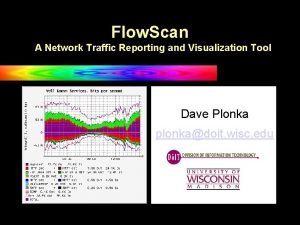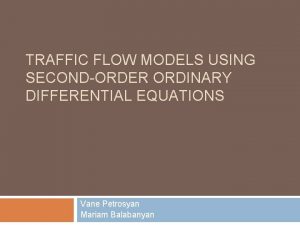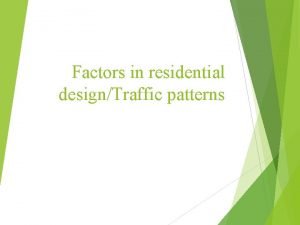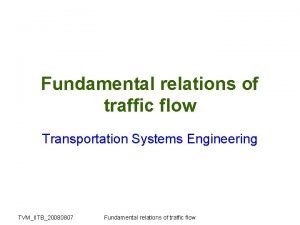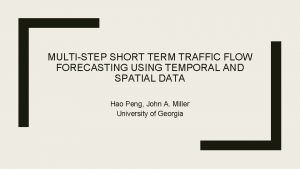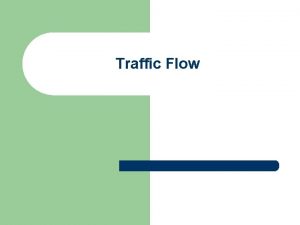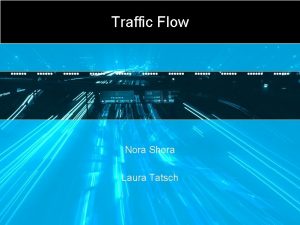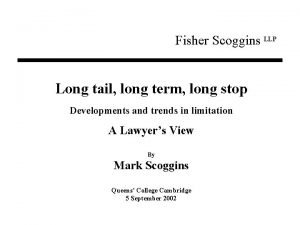Forecasting Traffic Flow Short Term Long Term and





















- Slides: 21

Forecasting Traffic Flow: Short Term, Long Term, and When It Rains Hao Peng, Santosh U. Bobade, Michael E. Cotterell and John A. Miller Department of Computer Science University of Georgia

System Motivations Performance parallel/distributed Support Advanced Time Series Analysis with uniform interface Provide Database storage and flexible queries Provide support for automation through ontology Exploit Theoretical and Simulation Models

Application Motivations Availability of Big Data through sensors Benefits of Research Intelligent Transportation System Traffic Apps Advanced Trip Planning Many existing studies Tend to focus on the immediate short term (e. g. , 1 -step ahead forecasts) Do not consider factors such as weather conditions

Time Series Analysis in the Big Data Era Database and Statistical Packages My. SQL + R JVM based Big Data Frameworks Spark. SQL + Spark Scala. Tion TSDB + Scala. Tion Analytics Python based Big Data frameworks pandas + tensorflow + keras

Scala. Tion TSDB + Scalation Analytics val start = new Time. Num("2017 -01 -01 -06: 00", "yyyy-MM-dd Z") val y = traffic. where[Time. Num](("Read Date", (x: Time. Num) => x >= start)) . select("Volume") . to. Vector. D(0) val model = SARIMA (y) model. train(). eval() println(model. fit) println(model. forecast(24))

Big Data Research is progressing towards larger datasets Current Study traffic in GA, ~50 MB Volume, Rainfall Next Study Austin, TX, ~150 MB Volume, Speed, Occupancy, Temperature, Relative Humidity, Wind Speed, Rainfall, Dewpoints Future Study Pe. MS, San Francisco & Los Angeles, CA, ~GBs

Progress in Analyzing Traffic Past: univariate time series, small number of datasets, immediate short term forecasts (e. g. , minutes) Current: deep learning, feed data into deep NNs Research Agenda Multivariate Time Series Weather, Spatial Dependencies, Events, Accidents, Road Repair Schedule Time Series Database (TSDB) Easy to use, combine database queries with analytics Theory driven models Theories can help to guide/restrict the model building process

Scala. Tion Project A Scala-based project for analytics, simulation and optimization Open source under an MIT License Forecasting models used in this study include Seasonal ARIMA Dynamic Regression Exponential Smoothing Feedforward multi-layer Neural Networks Long Short-Term Memory Neural Networks (under development) www. cs. uga. edu/~jam/scalation. html

Seasonal ARIMA Uses lagged and correlated values of the time series and errors to make forecasts Differencing may be necessary to make the time series stationary SARIMA(1, 0, 1)x(0, 1, 1)120 was the chosen model, as in [Williams and Hoel, 2003], [Shekhar and Williams, 2008] and [Lippi et. al, 2013]. Automated order search based on AICc as described in [Hyndman and Khandakar, 2007] was also attempted, but the automated models only yielded better results than SARIMA(1, 0, 1)x(0, 1, 1)120 for approximately one-third of the traffic sensor data.

Dynamic Regression Uses external variables such as rainfall to further explain additional variabilities in the traffic flow time series A simple, two-step process forecasting using both a time series model and a regression model

Exponential Smoothing Triple Exponential Smoothing with additive seasonality 12 -step ahead within sample forecast SSE was minimized to find the 3 smoothing parameters The default 1 -step ahead SSE was attempted, but resulted in very poor forecasting results for higher steps, possibly due to the lack of need to rely on seasonal components make good forecasts for 1 -step ahead.

Feedforward Neural Networks Tanh activation function was used Data were normalized to [-0. 8, 0. 8] Back-propagation was used to learn the weights and biases that minimize MSE 4 layer structure Input layer of size 50, including the data from previous 24 -hr period, the 24 -hr period in the previous week, the day of the week and time of the day Two hidden layers of size 40 and 30 Output layer of size 24, corresponding to 24 -step ahead forecasts Other parameters were optimized using grid search

Dataset Hourly traffic flow data Georgia Department of Transportation 74 sensors (both directions), mostly urban areas and major freeways Jan 2013 – June 2017 http: //www. dot. ga. gov/DS/Data Hourly Precipitation Data Automated Surface Observing System (ASOS) 14 sensors that are paired with nearby traffic sensors https: //mesonet. agron. iastate. edu/request/download. phtml? network=GA_ASOS

Traffic Sensors

Friday Traffic on US 23 in Atlanta, GA Much busier afternoon rush hours since everyone is getting off work and trying to go home The same road but for the other direction has much busier morning rush hours

Testing Platform Sapelo cluster from Georgia Advanced Computing Resource Center 48 -core AMD Opteron Machine Parallel training and testing were conducted per sensor per direction https: //gacrc. uga. edu/

Performance Evaluation Rolling Forecasts 12 weeks of data as training set (24 weeks if considering rainfall) 8 weeks of data as testing set Sliding window is 8 weeks Forecasts were made for 24 hours/steps into the future Models that incorporated rainfall data only made 1 hour/step ahead forecasts Difficult to make reliable, long-term weather forecasts Forecasts were only produced within the 7: 00 AM to 7: 00 PM range on weekdays Weekly historical averages by hours were used as baselines Mean Absolute Percentage Error (MAPE) was the metric of evaluation

Performance Comparison

Performance Comparison in Rainy Weather

Conclusions and Future Work Short and Long Term Traffic Flow Forecasting Weather conditions including rainfall can help to further explain traffic conditions Neural Networks performed well Preliminary results show that LSTM can be very promising Future Work Larger datasets with higher resolutions Additional models Exogenous variables, Multivariate Time Series

Questions
 Tall + short h
Tall + short h Long term and short term financial planning
Long term and short term financial planning Short term planning and long term planning
Short term planning and long term planning Short term hr planning
Short term hr planning Difference between long term and short term liabilities
Difference between long term and short term liabilities Difference between long term and short term liabilities
Difference between long term and short term liabilities Short term goals examples for students
Short term goals examples for students Long term memory vs short term memory
Long term memory vs short term memory Once upon a time, there lived
Once upon a time, there lived Pull questions
Pull questions Inbound traffic vs outbound traffic
Inbound traffic vs outbound traffic Intelligent traffic solutions
Intelligent traffic solutions Cash flow forecasting in software project management
Cash flow forecasting in software project management Private equity cash flow forecasting
Private equity cash flow forecasting Contoh perencanaan dan peramalan keuangan
Contoh perencanaan dan peramalan keuangan Network traffic reporting
Network traffic reporting Traffic flow differential equations
Traffic flow differential equations Traffic flow floor plan
Traffic flow floor plan Traffic flow analysis in retail management
Traffic flow analysis in retail management Thermodynamic relations
Thermodynamic relations Poem about tinikling
Poem about tinikling Long long ago when the gods and goddesses
Long long ago when the gods and goddesses















